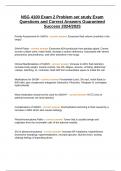NSG 4100 Exam 2 Problem set study Exam
Questions and Correct Answers Guaranteed
Success 2024/2025
Priority Assessment for SIADH - correct answer Excessive fluid volume (crackles in the
lungs)
SIAHA Patho - correct answer Excessive ADH production from pituitary gland. Cannot
excrete a dilute urine, retain fluids, develop a sodium deficiency. Associated with severe
pneumonia, pneumothorax, and other disorders in the lungs.
Clinical Manifestations of SIADH - correct answer Increase in ADH, fluid retention,
increase body weight, muscle cramps, low NA, fatigue, anorxia, vomiting, abdominal
cramps, twitching, sz, confusion, fluid shift from extracellular space to inside the cell
Medications for SIADH - correct answer Furosemide-Lasix, 3% nacl, restrit fluids to
800 ml/hr, give vasopressin antagonist (Vasostrict, Pitressin), Tolvaptan IV conivaptan
hydrochloride
What medication should not be used for SIADH? - correct answer HCTZ (Act on
adrenal hormones not renal tubeuls)
Complications of SIADH - correct answer Overhydrated swimming in fluid caused by a
increase in ADH which also causes lethargy
Pheochromocytoma Patho - correct answer Tumor that is usually benign and
originates from the chromaffin cells of the adrenal medulla.
S/S of pheocromocytoma - correct answer Increase BP, headache, hyperhidrosis
(excessive sweating), hypermetabolism, increase glucose, blurred vision, anxiety,
shaking feeling of impending doom.
, Diagnose for pheocromocytoma - correct answer Clonidine Suppression test, 24 hour
urine for catecholamines and metonephrine, abdominal ultrasound, MRI of pelvis.
Priority assessment for pheochromocytoma - correct answer Control the increase
blood pressure, DO NOT percuss or palpate, and assist in signs of nervous system
overactivity.
Treatment for pheochromocytoma - correct answer Alpha adrenergic blockers (works
by lowering blood pressure).
Priority assessment and interventions post-op thyroidectomy - correct answer Will see
fullness and tightness at the site and we need to have a trach at bedside.
Watch for audible stridor.
Best position for post-op thyroidectomy - correct answer Set patient at Semi-Fowlers
with two pillow support.
Pheochromocytoma Complications - correct answer Heart rate is high, and irregular
rhythm, high blood sugar, increased anxiety and increase BP
Thyroidectomy medication - correct answer Levothyroxine-lifelong use, levels needs to
be checked and adjusted, take in the morning before eating.
Levothyroxine S/F - correct answer Tremors, fast irregular heartbeats, SOB, fever, hot
flashes, sweating, headache, leg cramps, muscle aches.
After hypohysectomy you see clear nasal drainage what do you test for? - correct
answer Test the drainage for glucose.
Aldosteronism (Conn's Syndrome) - correct answer Excessive aldosterone production
usually occurs due to an aldosterone secreting tumor.




